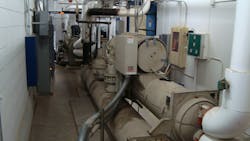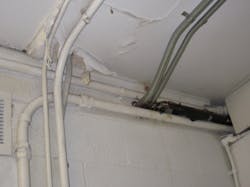Falling Behind: School Maintenance & Operations
“Today is a great and historic day,” district CEO Andres Alonso said in a message to district staff when the legislation passed. “It is historic because lawmakers from around the state have come together in a shared commitment to the students of Baltimore City, and a shared acknowledgment of the tremendous need they face for better learning environments.”
But the sizable investment in better school facilities represents less than half of unmet facility needs in Baltimore. The district’s 10-year plan, detailed in a 220-page report, “21st-Century Buildings for Our Kids,” says Baltimore would need cost $2.452 billion to bring its public school buildings up to minimally acceptable standards.
The situation is one that plays out frequently in schools and universities throughout the nation. Education institutions are grateful for whatever funding they can acquire to repair aging and outdated facilities, but the money they receive typically falls short of what is needed to provide students with adequate learning environments. Less critical maintenance tasks are set aside, and the list of deferred maintenance projects grows while schools wait for additional funds that never materialize.
By the numbers
How large a number must be attached to the problem of deferred maintenance in U.S. school facilities to persuade decisionmakers to give high priority to the state of educational facilities? Over more than 20 years, different organizations, public and private, have looked at the deficiencies in school infrastructure and have come up with a wide range of estimates of how much it would cost to bring education facilities into good condition.
Although the numbers vary, the findings had this in common: The money that was being allocated to address the problem was inadequate, and the problem would become only worse as buildings continued to wear out and break down.
Among the reports calling attention to deferred maintenance in schools:
•In 1989, the Education Writers Association released a report, “Wolves at the Schoolhouse Door,” that stated that public schools needed $41 billion to address facility maintenance and repairs.
•A 1992 report on the state of school facilities by the American Association of School Administrators, “Schoolhouse in the Red,” estimated that public school systems had more than $100 million in deferred maintenance projects.
•In 1995, the GAO (then the General Accounting Office, now renamed the Government Accountability Office) estimated that K-12 school facilities would need $112 billion to correct substandard conditions and carry out major repairs of problems such as leaking roofs, plumbing problems, inadequate heating systems or other system failures.
•The U.S. Department of Education’s National Center for Education Statistics released a follow-up report in 2000, “Condition of America’s Public School Facilities: 1999,” to determine what repairs, renovations and modernizations were needed to bring the nation’s public school buildings into good overall condition. It upped the estimate to $127 billion.
•The National Education Association also issued a report on school facilities in 2000, “Modernizing Our Schools: What Will It Cost?” The teachers union estimated the nationwide cost of repairing, renovating, or building school facilities and installing modern educational technology at $322 billion.
•In 2009, the 21st Century School Fund, an organization that advocates for modernizing education facilities, issued a report, “Repair for Success: An Analysis of the Need and Possibilities for a Federal Investment in PK-12 School Maintenance and Repair.” Using “a conservative estimate and extremely modest standards,” the report determined that U.S. public school facilities had $271 million in deferred maintenance.
•In 2011, the Council of the Great City Schools surveyed 50 major urban school districts that had 5.3 million students in 8,561 schools. The districts reported having $46.7 billion in repair, renovation, and modernization needs; and $14.4 billion in deferred maintenance needs.
•Now in 2013, the U.S. Green Building Council’s Center for Green Schools has issued a report, “State of Our Schools 2013,” that takes the 21st Century School Fund’s $271 million estimate and adds to it modernization costs that would enable U.S. schools to meet current education, safety and health standards. The grand total: $542 billion.
“If schools were to be modernized on a 25-year lifecycle—a defensible schedule, given rapid changes in building technology, educational demands and population change—$542 billion would be required over the next 10 years to modernize our pre-K-through-12th grade educational infrastructure,” the report asserts.
Showing their age
When facilities are neglected for too long, the task of fixing them is one school systems can’t carry out by themselves. The Baltimore district’s facilities plan, “21st-Century Buildings for Our Kids,” notes that 23 percent of the district’s buildings were constructed before 1946, and another 74 percent were built between 1946 and 1985; only 3 percent have been constructed since 1985, most of them modular and portable.
“Costs to operate, maintain and repair old buildings that are in poor condition increase every year,” the report asserts. “As the buildings get older and continue to deteriorate, the more it costs to maintain buildings from falling into further disrepair.”
An assessment of Baltimore’s facilities concluded that 125 of 183 school buildings were considered to be in very poor condition.
Too many students “are learning in school buildings with old boilers and no air conditioning; drinking fountains that can’t be used; windows that are old, yellowed and can’t be opened; and classrooms that lack the wiring to support computers,” the report says.
The report made the case that Baltimore had fallen so far behind that it could not solve its facility problems without an infusion of resources.
“With an annual construction budget of approximately $56 million a year … there is no way (Baltimore) could ever provide the school buildings its students deserve—absent a plan that is aggressive and strategic,” the report says.
The plan, endorsed by the Baltimore school board in January, created an impetus for the $1 billion funding plan approved by Maryland lawmakers. A combination of funding from the state, city and school district will pay for the building improvements.
Funding gap
When maintenance tasks are put off too long, they can grow to the point that they are too costly for a school system’s budget for ongoing maintenance. Districts often have to turn to their constituents to approve bond issues to cover deferred maintenance.
That was the path the Clark County (Nev.) district tried to take last year. For years one of the nation’s fastest growing systems and now the fifth-largest, Clark County has spent billions of dollars constructing new campuses to provide classrooms for the burgeoning student population. But it had been straining to keep up with maintenance and repairs at older facilities, especially as economic difficulties hit the Las Vegas area hard. A $720 million tax proposal was placed on the November ballot to provide funds need for renovations at older campuses.
The ballot question was soundly defeated, and the district’s maintenance and operations staff has to try to keep up with growing demands for repairs in aging buildings. With a limited staff and a massive amount of square footage to cover—more than 34 million square feet in 357 schools and 35 administrative facilities—the maintenance department faces an uphill battle carrying out its duties effectively.
Statistics show Clark County has to devote more resource to emergency and corrective jobs instead of preventive maintenance, according to a report from the district’s maintenance department. Workers responded to more than 95,000 job requests in the 2011-12 school year; 5 percent were for emergency maintenance, and 81 percent were for corrective maintenance. Only 13 percent were for preventive maintenance.
The district says it has the equivalent of 430 full-time maintenance positions; industry standards suggest Clark County should have 1,212. In 1990, the district had one maintenance department staff member for every 54,255 square feet of space; in 2012, it had one maintenance worker for every 80,597 square feet. (The industry recommendation is one employee for 28,585 square feet.)
Beyond adequacy
In calling for education policymakers to act more swiftly to address deferred school maintenance, the Center for Green Schools says education institutions should not have to settle for learning environments that meet minimal standards of acceptability.
“An adequate school facility is more than just a building that is in good repair,” the report contends. “A school facility needs to be safe, healthy, educationally appropriate and environmentally sustainable.”
Research on how school facilities affect student performance has indicated that air quality, acoustics, levels of thermal comfort and levels of daylight affect the stress levels, health and well-being of occupants in schools, the report notes. “Studies have found that higher levels of student achievement, controlled for socio-economic status, are associated with better quality facility design and condition,” the Center says.
Better data
Much of the initial attention that the Center for Green Schools report was on the budget-busting cost estimate of school facility needs, but the report’s initial recommendation focuses more on gathering better information on the scope of the problem.
“Lack of sufficient, comparable (state-to-state and year-to-year) facility data aligned to basic education data is hindering our ability to address the safety, health, educational and environmental challenges of our public school facilities,” the center contends. “At the federal, state, school district and individual school levels, the public needs to understand both the current extent of problems in our facilities and the educational opportunities that high quality public school facilities provide. We need to know the distribution of facility needs and the risks associated with deferred maintenance, crowded schools and insufficient capital investment.”
The center wants the GAO to conduct an updated assessment of U.S. school facilities and begin doing one every 10 years. It has sent a letter sent to leaders of the education committees in the U.S. House and Senate, urging them to authorize the GAO.
“The results from a new GAO study on the condition of our school facilities would greatly benefit the hard work of school districts, teachers, parents and organizations around the country toward ensuring that every child can learn in a safe, efficient school within this generation,” the letter says.
Marissa Long, public relations director for the center, says that the organization has been working with the GAO since the “State of the Schools” report was released and is confident that the office will decide to conduct another assessment of the condition of U.S. school facilities to help educators and policymakers determine the extent of the needs.
How quickly such a report would be conducted is unclear, but Long says the Center for Green Schools hopes to be involved in carrying out the assessment.
“We’re making really great progress,” Long says.
Sidebar: Grade=needs improvement
The American Society of Civil Engineers has assessed the condition of the nation’s public school infrastructure in a way that educators will understand: A report card.
But schools won’t make the honor roll with the grade: D.
That’s better than the F that the engineers gave to school infrastructure in 1998, or the D-minus in 2001. The D bestowed on school facilities in 2005, 2009 and again in 2013 is an indication that schools have made some progress in addressing maintenance backlogs since greater attention was given to the issue in the 1990s, but the response has been inadequate to confront the scope of the problem.
In its 2013 Report Card for America’s Infrastructure, the society notes that since the 2008 recession, spending on education facilities has declined significantly, “while the condition of school facilities continues to be a significant concern for communities.”
Like the Center for Green Schools’ recent report on school facilities, the civil engineers say a key obstacle in the effort to provide enough resources for school maintenance and repairs is a lack of accurate data about the extent of the needs. The report card urges the federal government to begin providing regular updates on the condition of public school facilities nationwide.
Other recommendations for school systems and those controlling education purse strings:
•Encourage school districts to adopt regular, comprehensive major maintenance, renewal and construction programs.
•Expand federal and state tax credits and matching funds to support increased use of school construction bonds and simplify the process for school districts to obtain construction financing.
•Explore alternative financing, including lease financing and financing as well as ownership and use arrangements, to facilitate construction projects.
•Begin comprehensive preventive-maintenance programs to extend the life of school facilities.
•Require life-cycle cost analysis principles and multi-use possibilities to evaluate the total costs of projects to capture efficiency and promote sustainability.
•Encourage school facility reviews on a state level and provide input to develop a national database of conditions and available funding.
Sidebar: Higher-education needs
Most of the attention given to deferred maintenance in education facilities focuses on K-12 schools, but higher-education campuses are victims of the trend, too. Estimates of deferred maintenance at colleges and universities range from $26 billion to more than $50 billion.
A Kansas Board of Regents report from fall 2012 on deferred maintenance at eight university campuses in the state found that 433 “mission-critical” buildings had a deferred maintenance backlog of $762 million. In addition, the institutions need to spend $93 million a year in ongoing maintenance to prevent the backlog from increasing.
The maintenance backlog has arisen because of a lack of funding and the age of the facilities.
“Over the past 35 years, the universities received insufficient rehabilitation and repair funding,” the report says.
The $762 million figure is lower than the $904 million identified in the Regents’ Fall 2010 report. The drop is attributed in part to additional funding, such as federal stimulus allocations, and more favorable costs because of a slow economy.
In South Carolina, the state’s Commission on Higher Education has estimated that as of November 2012, education and general buildings on 33 campuses in the state had $1.27 billion in building and infrastructure maintenance needs. Education and general buildings are those with 25 percent or more space dedicated to educational and general activities and that have more than 3,000 square feet.
The South Carolina campuses had 813 facilities categorized as education and general buildings.
Kennedy is staff writer for AS&U.
About the Author
Mike Kennedy
Senior Editor
Mike Kennedy, senior editor, has written for AS&U on a wide range of educational issues since 1999.



